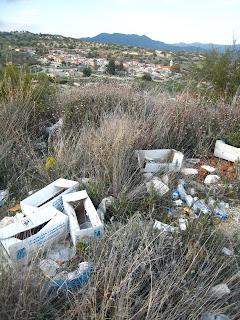 Romance or reality: what do travellers really want to read in guidebooks? Cyprus is dotted with delightful villages of winding lanes and atmospheric stone houses sprawling down hillsides in woody valleys. Sturdy old ladies can be seen carting bundles of wood down the street on their backs and old men ride donkeys through town, the guidebooks tell us. And it’s true. But unfortunately many of the villages are now ghost towns, their ramshackle old stone houses boarded up, their gardens unkempt, junk crowding their yards, and trash dumped down hillsides on the outskirts of town. The young people have moved to the cities or overseas to work and the few residents that are left are over 60, enjoying their last years in the village they have loved and known all their lives, and struggling alone to maintain their traditional way of life. Well, they’re not so alone. It’s not uncommon to see a wrinkled old lady in headscarf and apron sitting in her doorway, taking in some sun and watching the passing traffic – and next to her see a bored young Filipina or Indian woman, perhaps employed by the guilty son or daughter as a companion-cum-maid to watch over their abandoned parent. You don’t read any of this in the guidebooks.
Romance or reality: what do travellers really want to read in guidebooks? Cyprus is dotted with delightful villages of winding lanes and atmospheric stone houses sprawling down hillsides in woody valleys. Sturdy old ladies can be seen carting bundles of wood down the street on their backs and old men ride donkeys through town, the guidebooks tell us. And it’s true. But unfortunately many of the villages are now ghost towns, their ramshackle old stone houses boarded up, their gardens unkempt, junk crowding their yards, and trash dumped down hillsides on the outskirts of town. The young people have moved to the cities or overseas to work and the few residents that are left are over 60, enjoying their last years in the village they have loved and known all their lives, and struggling alone to maintain their traditional way of life. Well, they’re not so alone. It’s not uncommon to see a wrinkled old lady in headscarf and apron sitting in her doorway, taking in some sun and watching the passing traffic – and next to her see a bored young Filipina or Indian woman, perhaps employed by the guilty son or daughter as a companion-cum-maid to watch over their abandoned parent. You don’t read any of this in the guidebooks.
Monday, March 17, 2008
Romantic representations in guidebook writing: case study #1
Posted by
Lara Dunston
at
12:47 PM
![]()
Labels: Cyprus, guidebooks, the reality of travel
Subscribe to:
Post Comments (Atom)


























No comments:
Post a Comment